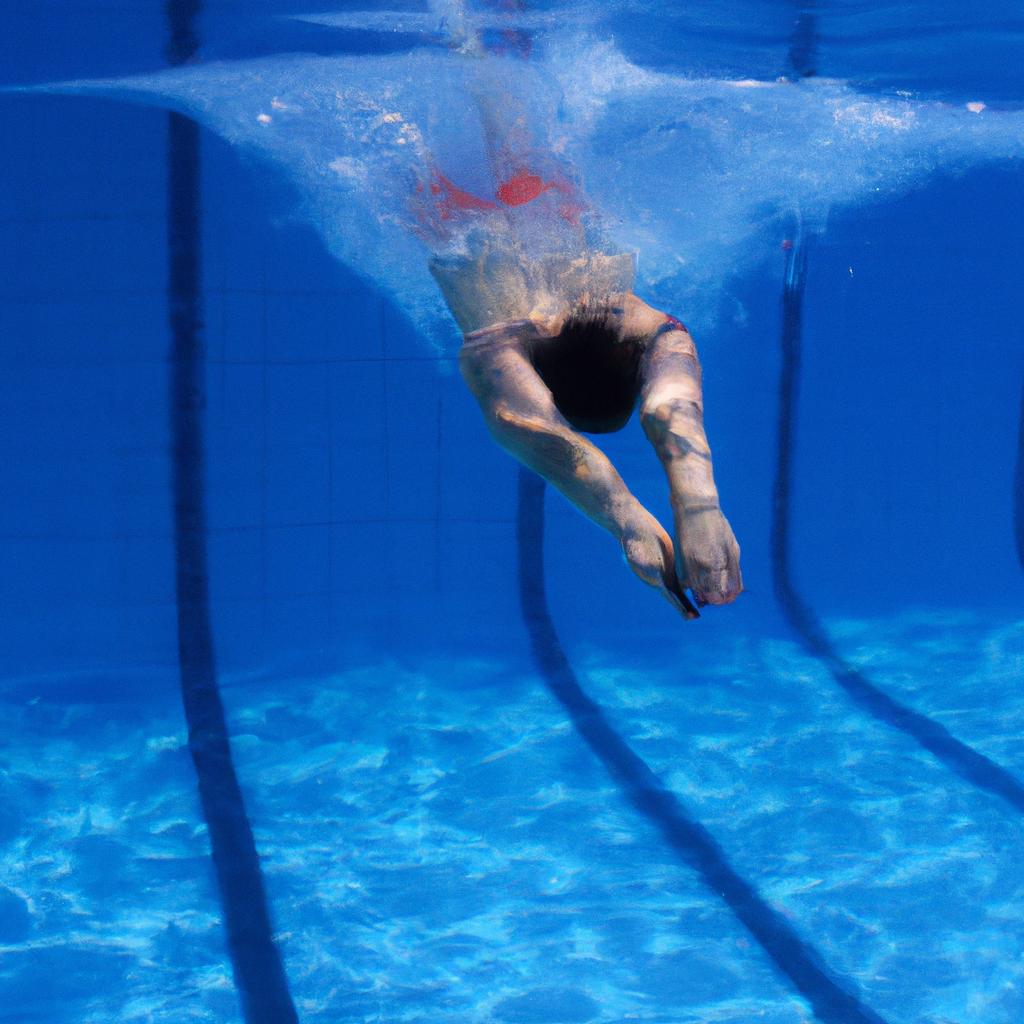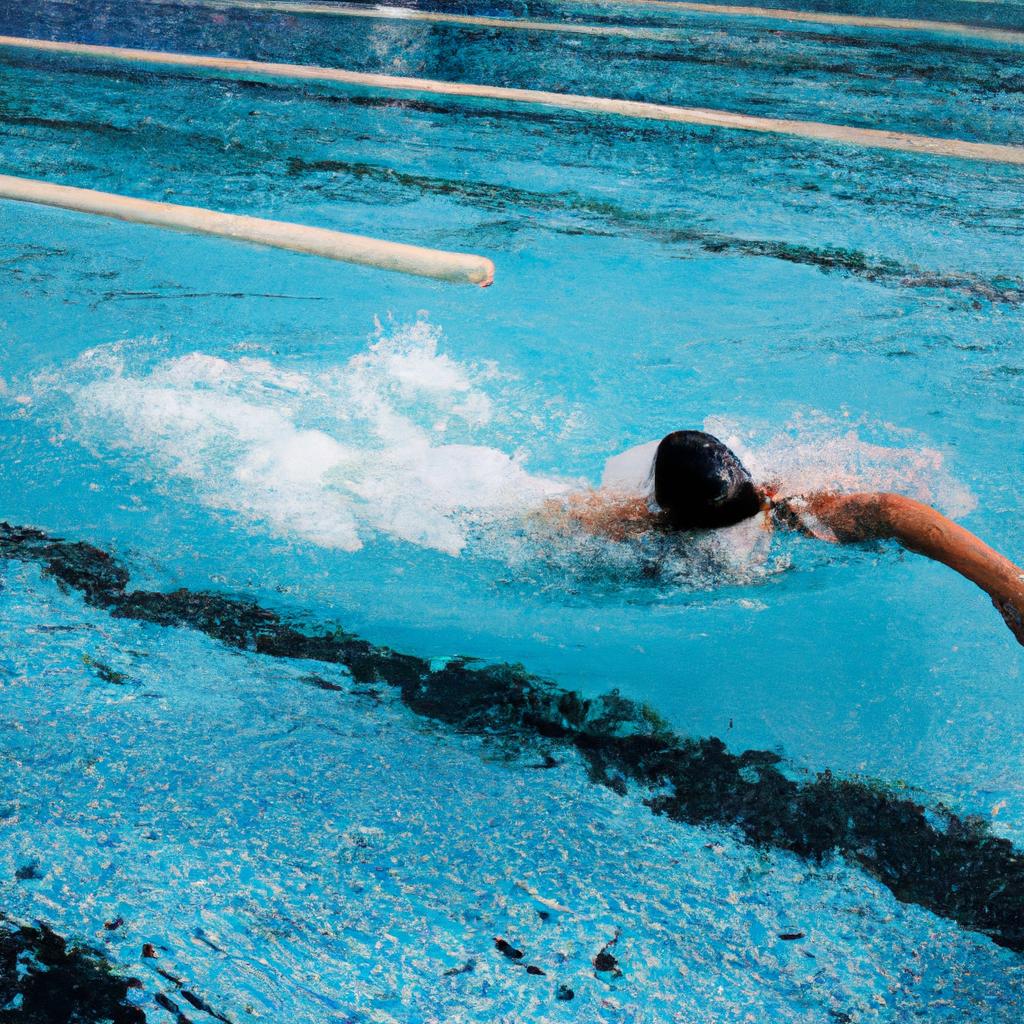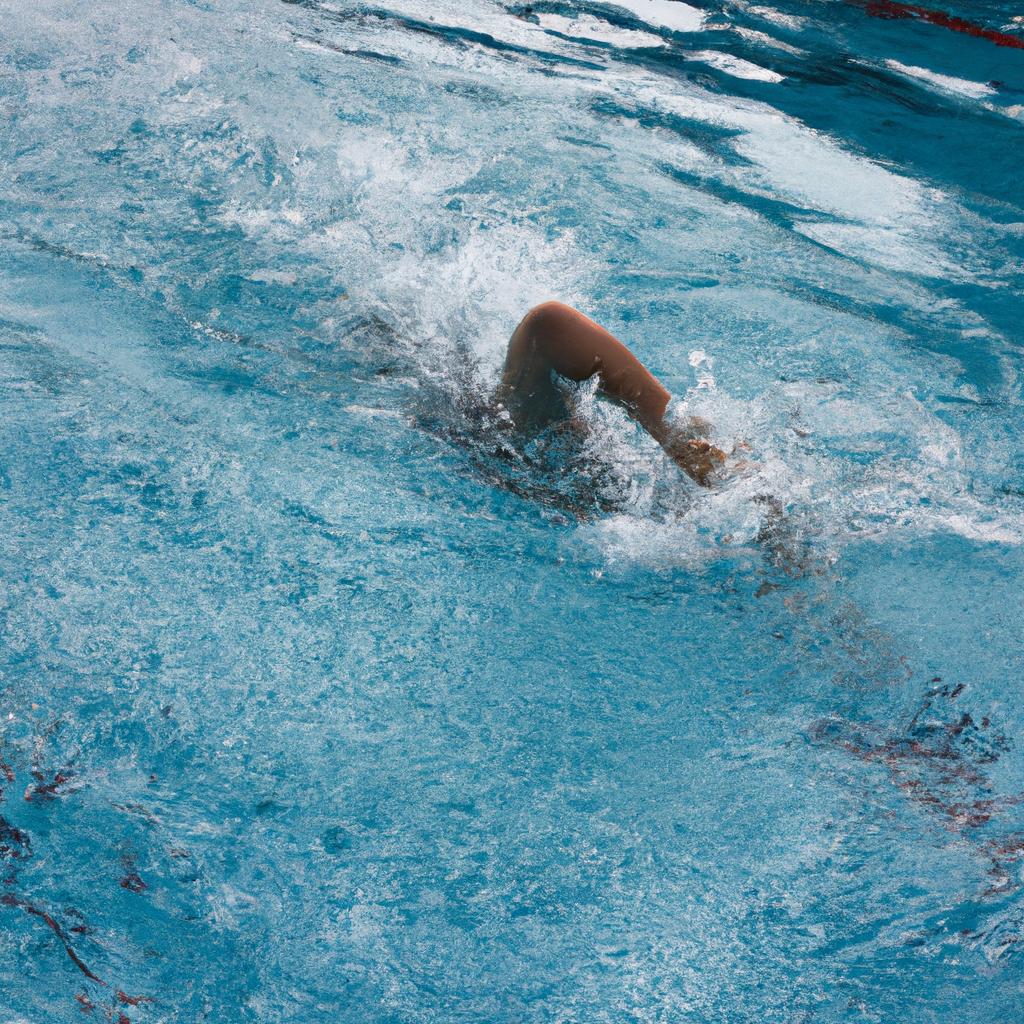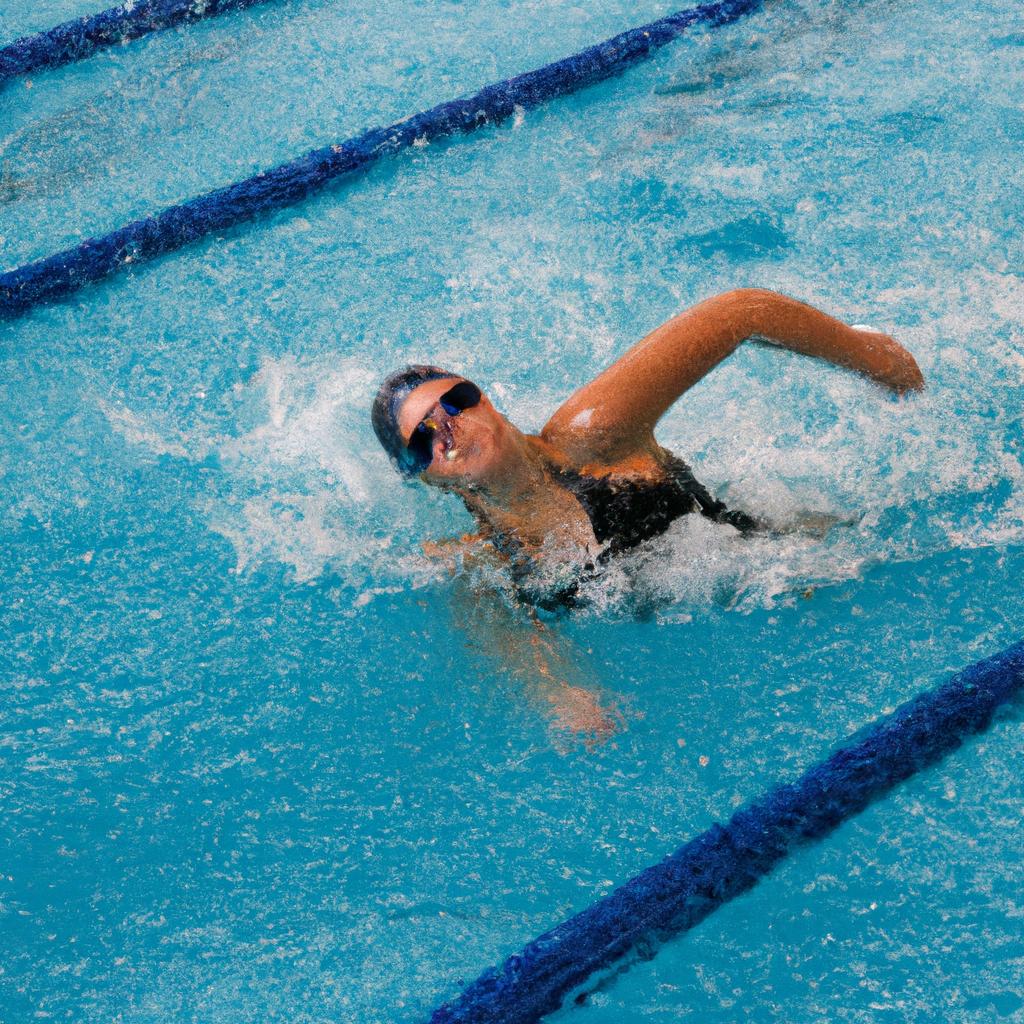The vast expanse of open water presents a unique and challenging environment for swimmers, where the boundaries are blurred between sport and nature. In this article, we explore the context of swimming in open water within the realm of sports. To illustrate this topic, let us consider the case study of Maria, an avid competitive swimmer who decided to venture beyond the confines of a pool and participate in her first open water race. This hypothetical scenario serves as a backdrop to delve into the intricacies and complexities that arise when swimming takes place outside regulated swimming pools.
Open water swimming has gained significant popularity in recent years, attracting athletes from various backgrounds seeking novel experiences and fresh challenges. Unlike traditional pool-based competitions where swimmers navigate fixed distances with clear demarcations, open water races introduce dynamic factors such as changing currents, variable temperatures, and unpredictable weather conditions. These elements not only test one’s physical stamina but also demand adaptability and strategic thinking during the course of a race. Consequently, understanding how swimming in open water fits within the broader framework of sports becomes crucial to comprehending its distinct characteristics and appreciating its significance as both a physical activity and a competitive endeavor.
As we embark on exploring the intersection between open water swimming and sports, it is essential to recognize the unique set of skills and attributes that swimmers must possess in order to excel in this particular discipline. While pool swimming primarily focuses on speed, open water swimming requires a combination of endurance, navigational abilities, and mental resilience. Swimmers must be able to sustain their energy over long distances, adapt to changing environmental conditions, and effectively navigate through unfamiliar terrains.
Moreover, the absence of lane lines and walls in open water races introduces a sense of unpredictability that adds an additional layer of complexity to the sport. Swimmers must contend with crowded starts, potential contact with other competitors, and the challenge of finding optimal racing lines amidst turbulent waters. These factors demand not only physical strength but also strategic decision-making and tactical awareness.
In terms of safety considerations, open water swimming poses its own set of challenges compared to pool swimming. Athletes must be mindful of potential hazards such as marine life encounters or adverse weather conditions that can impact their performance and well-being. The ability to assess risks and make informed choices is therefore essential for swimmers engaging in open water races.
Overall, understanding the context of open water swimming within the realm of sports allows us to appreciate the skillset required for success in this discipline. It highlights the importance of endurance, adaptability, strategy, and risk management – all elements that contribute to making open water swimming a captivating and demanding sport. As more athletes venture into these uncharted waters, further exploration and analysis will undoubtedly shed light on new insights into this growing field within the world of sports.
The Evolution of Aquatic Sports
Swimming has been an integral part of human culture and history for centuries. From ancient civilizations to modern times, the practice of swimming has evolved significantly, leading to the development of various aquatic sports. This section will explore the evolution of these sports from their earliest forms to their current status as prominent events in international competitions.
To better understand the progression of aquatic sports, let us consider a hypothetical case study: imagine a small coastal community where swimming was primarily done for survival purposes such as fishing or escaping dangers at sea. Over time, this community recognized that swimming could also be enjoyed as a recreational activity, which led to organized races among its members. These early competitive swims laid the foundation for what would become formalized aquatic sports.
As societies expanded and trade routes were established, different cultures embraced swimming not only as a means of transportation but also as a form of entertainment. The popularity of swimming spread across continents, resulting in diverse variations and regional adaptations. For example:
- In Greece, swimming became an essential component of physical education and military training.
- In Japan, traditional water games like “suikawari” (watermelon splitting) developed into organized water-based competitions.
- Indigenous tribes in North America incorporated swimming into religious ceremonies and rites of passage.
This diversification gave rise to distinct styles and techniques specific to each region’s cultural context. As communities began interacting with one another through exploration and colonization, these unique practices merged and influenced one another, further enriching the world’s repository of aquatic sports.
In order to evoke an emotional response related to the significance and impact of aquatic sports throughout history, we can reflect on some key points:
- Swimming transcends language barriers: Regardless of nationality or background, people around the globe are united by their ability to swim and appreciate its universal allure.
- Aquatic sports promote inclusivity: By embracing diversity in terms of gender, race, age, and physical ability, these sports provide opportunities for individuals to thrive within a supportive community.
- The sense of freedom in the water: Swimming transcends terrestrial limitations, allowing individuals to experience liberation from gravity and explore new dimensions.
- The exhilaration of competition: Aquatic sports foster healthy competition, pushing athletes to test their limits physically and mentally while inspiring others through their achievements.
In addition to these emotional connections, it is important to highlight the significance of aquatic sports through visual representation. Below is a table showcasing a few prominent events in various aquatic sports:
| Sport | Event | Location |
|---|---|---|
| Swimming | 100m Freestyle | Olympic Games |
| Diving | Synchronized Platform | World Championships |
| Water Polo | Men’s Final | FINA World Cup |
| Open Water | Marathon Swim | FINA Grand Prix |
By examining the evolution of swimming and its impact on the development of aquatic sports, we can appreciate how this ancient practice has transformed into a global phenomenon. In the subsequent section about “Competitive Swimming Events,” we will delve deeper into specific competitions and shed light on their intricate details and rules without abruptly transitioning between sections.
Competitive Swimming Events
In the realm of aquatic sports, open water swimming has emerged as a captivating and demanding discipline. Unlike traditional pool-based swim competitions, this form of swimming takes place in natural bodies of water such as lakes, oceans, or rivers. The unique nature of open water swimming presents athletes with an array of challenges that test their endurance, adaptability, and strategic thinking.
To illustrate the grueling nature of open water swimming, let us consider a hypothetical scenario. Imagine a group of experienced swimmers participating in a marathon swim across the English Channel. They embark on this daunting journey early in the morning when the waters are calm but soon encounter unpredictable currents and changing weather conditions. As fatigue sets in and waves crash against them relentlessly, these swimmers must summon all their physical strength and mental fortitude to reach their destination.
Open water swimming offers several distinct characteristics that set it apart from its pool-based counterpart:
- Vastness: In contrast to the confined space of a pool lane, open water provides vast expanses for swimmers to navigate through.
- Environmental Factors: Swimmers must contend with ever-changing elements such as wind direction, wave height, temperature fluctuations, marine life encounters, and even potential pollution.
- Navigation Challenges: Unlike following clearly marked lines on the bottom of a pool, open water swimmers often rely on visual cues or GPS devices to chart their course amidst vast stretches where land is not visible.
- Strategy: Strategic decisions become crucial during races as swimmers aim to find optimal routes that minimize resistance from currents while maximizing efficiency.
The table below summarizes some key differences between competitive pool swimming and open water swimming:
| Pool Swimming | Open Water Swimming | |
|---|---|---|
| Venue | Indoor/Outdoor Pools | Natural Bodies of Water |
| Distance | Predetermined | Variable |
| Turns | Frequent | Minimal |
| Water Conditions | Controlled | Unpredictable |
Transitioning from the challenges of open water swimming, we will now explore its counterpart – competitive swimming events in organized pools. By examining these distinct aspects of aquatic sports, we can gain a comprehensive understanding of how swimming fits into the broader context of physical fitness and athletic performance.
The Role of Swimming in Physical Fitness
Transitioning from the previous section on competitive swimming events, we now turn our attention to open water swimming in the context of recreational activities. To illustrate the significance of this form of swimming, let us consider a hypothetical scenario involving Sarah, an amateur swimmer who decides to challenge herself by participating in her first open water race. As she plunges into the vast expanse of the ocean, surrounded by fellow swimmers and cheered on by spectators, Sarah experiences a unique blend of excitement, thrill, and personal accomplishment.
Open water swimming offers individuals a chance to engage with nature while pushing their physical limits. From lakes and rivers to oceans and bays, these aquatic environments present challenges that differ greatly from those encountered in controlled pool settings. Here are some factors that make open water swimming distinct:
- Variable conditions: Unlike pools where temperature and water quality can be regulated, open water swimmers must contend with unpredictable elements such as currents, tides, wind patterns, and varying temperatures.
- Navigation skills: In open water races or leisurely swims across large bodies of water, participants need to develop navigation techniques using landmarks or buoys instead of relying solely on lane lines at the bottom of a pool.
- Psychological resilience: The absence of clear boundaries can give rise to anxiety or fear for some swimmers. Overcoming these mental barriers requires psychological strength and perseverance.
- Sense of adventure: Open water swimming often appeals to those seeking new challenges or wanting to break away from the monotony associated with pool training routines. It provides an opportunity for exploration and discovery amidst stunning natural landscapes.
To further emphasize the diverse appeal of open water swimming as a recreational activity, consider Table 1 which highlights key differences between competitive pool swimming and open water swimming:
Table 1: Contrasting Competitive Pool Swimming with Open Water Swimming
| Pool Swimming | Open Water Swimming | |
|---|---|---|
| Environment | Controlled | Unpredictable |
| Distance | Fixed | Varied |
| Competition | Yes | Optional |
| Challenge | Speed and Technique | Navigation and Endurance |
In conclusion, open water swimming provides a unique experience that appeals to individuals seeking adventure, physical challenges, and a connection with nature. As we will explore in the subsequent section on “The Psychology of Open Water Swimming,” this form of swimming also has a profound impact on the mental well-being of participants.
Transitioning into the next section about “The Psychology of Open Water Swimming,” it is important to understand how swimmers’ minds are influenced by their experiences in open water environments.
The Psychology of Open Water Swimming
Section H2: The Psychology of Open Water Swimming
Building upon the physical benefits, understanding the psychology behind open water swimming is crucial in comprehending its significance as a sport. By delving into the mindset and emotions associated with this activity, we gain insights into how individuals navigate challenges and harness their mental strength to excel in aquatic sports.
The allure of open water swimming lies not only in its physical demands but also in the psychological aspects that come into play. Consider Sarah, an avid swimmer who decided to venture beyond traditional pool settings and participate in her first open water race. As she stood at the starting line, surrounded by vast expanses of untamed waters, her heart raced with anticipation and apprehension about what lay ahead. This example illustrates how athletes’ mental states significantly influence their performance when faced with unpredictable environments.
To better understand the psychology of open water swimming, several key factors are worth exploring:
- Fear and Anxiety Management: Open water swimmers often face unique fears related to unknown depths, marine life encounters, or harsh weather conditions. Developing strategies to cope with these anxieties can enhance performance and ensure safety.
- Mental Toughness: Sustaining motivation amidst unexpected circumstances requires resilience and mental fortitude. Athletes must cultivate determination and adaptability to overcome obstacles encountered during races.
- Focus and Concentration: Maintaining concentration for prolonged periods becomes critical during long-distance events where distractions abound. Focusing on stroke technique, navigation skills, and staying mentally present aids swimmers in achieving optimal performance.
- Risk Assessment: Assessing risks involved while competing in open water is essential for both competitive success and personal safety. Swimmers should learn to evaluate environmental hazards such as currents, temperature changes, or potential collisions.
To highlight the emotional impact of open water swimming further, consider the following table showcasing various sentiments experienced by athletes before and during these challenging races:
| Emotions Before the Race | Emotions During the Race | Emotions After the Race |
|---|---|---|
| Excitement | Determination | Accomplishment |
| Apprehension | Focus | Satisfaction |
| Anticipation | Perseverance | Relief |
| Nervousness | Resilience | Pride |
Understanding these emotions can foster a deeper appreciation for the psychological resilience required in open water swimming. By recognizing and managing fears, maintaining focus, developing mental toughness, and assessing risks effectively, athletes are better equipped to succeed in this demanding sport.
As athletes immerse themselves in aquatic sports, it is imperative to prioritize safety measures that safeguard participants during races. Let us now explore how organizers and swimmers alike ensure a secure environment conducive to competitive excellence.
The Safety Measures in Aquatic Sports
Building upon our understanding of the psychology behind open water swimming, it is important to explore the safety measures implemented in aquatic sports. By examining these precautions, we can gain a deeper appreciation for the balance between risk and enjoyment that defines this unique domain.
Safety Measures in Aquatic Sports
To illustrate the significance of safety measures, let’s consider a hypothetical scenario. Imagine an international open water swimming competition taking place in treacherous ocean conditions. Athletes from around the world gather to test their limits against powerful waves and unpredictable currents. In such high-risk situations, stringent safety protocols become imperative to ensure both the physical well-being and psychological confidence of participants.
Considerations when implementing safety measures:
- Risk assessment: Prior to each event, thorough evaluations must be conducted to assess potential hazards specific to the location and environmental factors. This includes analyzing wave patterns, tidal movements, water temperature fluctuations, and marine life presence.
- Lifeguard deployment: Highly trained professionals equipped with necessary rescue tools should be strategically positioned along the course to swiftly respond in case of emergencies. Their expertise helps mitigate risks by offering immediate assistance if needed.
- Safety equipment requirements: All swimmers must adhere to strict guidelines regarding personal protective gear such as wetsuits, goggles, earplugs, and swim caps. These items not only protect against external elements but also enhance visibility and promote buoyancy.
- Emergency response systems: A comprehensive emergency plan needs to be established before any event begins. This involves coordinating with local authorities for rapid medical response on land or sea if any participant encounters distress during the race.
Table: Importance of Safety Measures in Aquatic Sports
| Key Considerations | Impact |
|---|---|
| Risk assessment | Ensures athlete safety through accurate identification of potential dangers |
| Lifeguard deployment | Provides timely intervention and support during emergencies |
| Safety equipment requirements | Minimizes injury risks while enhancing performance capabilities |
| Emergency response systems | Ensures prompt medical assistance in case of distress |
Looking ahead, the implementation of safety measures will continue to evolve as technology advances and our understanding of aquatic environments deepens. By prioritizing athlete well-being without compromising the essence of open water swimming, we can foster a positive environment that encourages participation and pushes boundaries.
As we reflect on the importance of safety measures in aquatic sports, it becomes evident that their integration is crucial for both athletes’ welfare and optimal performance. In light of this, let us now explore “The Future of Swimming as a Sport” and envision how advancements may shape its trajectory.
The Future of Swimming as a Sport
Building upon the importance of safety measures in aquatic sports, it is crucial to examine the future trajectory of swimming as a sport. With advancements in technology and evolving societal attitudes towards physical activities, understanding the potential developments and challenges that lie ahead can provide valuable insights into the future landscape of competitive swimming.
To illustrate how swimming may evolve, let us consider a hypothetical scenario involving an Olympic swimmer named Emily. Emily has been training diligently for years, pushing herself beyond her limits to achieve excellence in her discipline. However, she faces various obstacles unique to her generation of swimmers.
-
Technological Innovations:
- Advanced swimsuits with enhanced hydrodynamics could potentially improve performance significantly.
- Underwater camera systems capturing every angle and movement would allow coaches to analyze technique more accurately.
- Virtual reality simulations enabling athletes like Emily to visualize and practice races before they even step foot in a pool.
-
Changing Training Methods:
- Incorporation of data-driven approaches using wearable devices tracking heart rate, stroke efficiency, and other metrics would optimize training regimens.
- Cross-training programs integrating yoga or Pilates to enhance flexibility and prevent injuries might become more prevalent.
- Mental fitness training focusing on mindfulness techniques could help swimmers better manage anxiety during competitions.
-
Environmental Considerations:
- The impact of climate change on open water events necessitates adaptation strategies such as adjusting race locations or implementing stricter heat regulations.
- Water purification technologies ensuring safe conditions for outdoor competitions will be vital.
- Increased recognition and support from governing bodies may result in improved funding opportunities for aspiring swimmers.
- Growing emphasis on inclusivity may lead to greater accessibility for individuals with disabilities through adaptive swimming programs.
- Promotion of gender equality within the sport may encourage more female participation at all levels.
- Heightened awareness of mental health in sports may prompt the implementation of support systems for athletes like Emily.
To further explore these potential developments, it is useful to analyze a three-column, four-row table outlining the possible changes and challenges that swimming as a sport might encounter:
| Future Developments | Challenges | Implications |
|---|---|---|
| Technological advancements in swimwear | Ethical considerations regarding fairness and equality | Enhanced performance and potentially faster race times |
| Data-driven training methods | Overreliance on technology leading to decreased focus on instinct and intuition | Improved efficiency and injury prevention |
| Environmental adaptations for open water events | Logistical complexities associated with changing locations or implementing heat regulations | Ensuring fair competition while prioritizing athlete safety |
| Societal shifts towards inclusivity | Resistance from traditional perspectives | Increased diversity and equal opportunities within the sport |
In summary, the future of swimming as a sport holds immense potential for growth. Technological innovations, evolving training methods, environmental adaptations, and societal attitudes all contribute to shaping this landscape. As aspiring swimmers like Emily navigate through these changes and overcome various challenges, they will continue to shape the competitive world of swimming into an even more dynamic arena where athleticism, innovation, and inclusivity thrive.










